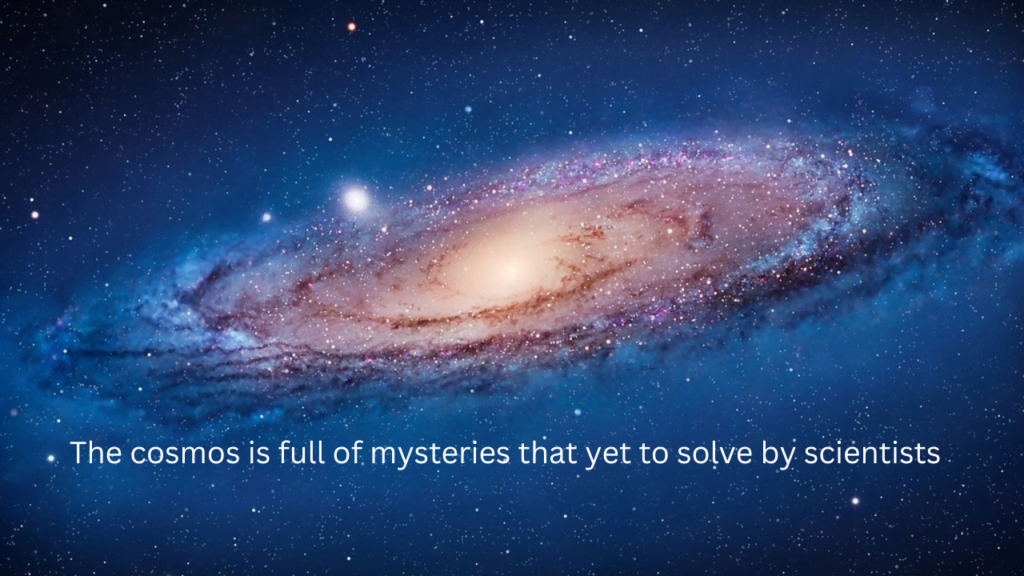
According to research by Prof. Rajendra Gupta of uOttawa, it isn’t real and has never been, which contradicts the conventional understanding of cosmology.
The Astrophysical Journal, an academic journal that is subject to peer review, published the study’s results.
The findings of this study raise doubt on long-held scientific beliefs about the structure of the universe and question our understanding of it.
Reconsidering Dark Matter’s Role in Galactic Rotation and Gravitational Lensing
If this study is accurate and dark matter doesn’t exist at all, then it’s crucial to first grasp what dark matter is truly not—or rather, what we assumed it was.
According to theory, dark matter accounts for more than 85% of the matters in the observable universe and is an invisible material that emits no light.
Furthermore, according to the mainstream model of cosmology, it is thought to be essential to the universe’s ongoing evolution.
However, given that dark matter is invisible, how did scientists discover its abundance and the extent of its putative significance to the cosmos?
Gravity is the answer. General Relativity by Albert Einstein provides an explanation for gravity as we understand it. Anything that it is unable to explain is typically attributed to dark matter’s effect.
Rotation of galaxies is one instance of this. Science states that the rotation velocities of spiral galaxies around the galactic center will decrease with increasing distance from the center. However, that does not occur. Rather, the velocity decreases and everything remains flat.
If there had been a lot of mass inside the galaxy that was invisible to the naked eye, this may have happened without violating any rules of physics. The mass distribution would shift as a result.
Gravitational lensing is another example of this phenomenon, in which an object of such immense mass exhibits lensing effects on light, allowing scientists to observe objects that ought to be obscured. Even though we can’t see dark matter, gravitational lensing should be able to help determine how much mass something has. This should help determine how much dark matter is in a certain galaxy.
Overall, there is an enormous amount of scholarly research on dark matter that unequivocally attests to both its significance and existence.

However, this study—which was prepared solely by Prof. Rajendra Gupta—changes everything by putting forth the outrageous theory that dark matter cannot exist and does not exist.
“There are several papers that question the existence of dark matter, but mine is the first one, to my knowledge, that eliminates its cosmological existence while being consistent with key cosmological observations that we have had time to confirm,” he stated in a press release.
How could Gupta appear to refute the existence of dark matter since it is thought to be so significant and there is sufficient evidence for it?
The answer rests in a model that combines two theories about the universe, covarying coupling constants, and tired light.
The first of them relates to a fundamental idea in physics about the amount of force required in an interaction and how that force varies with time. In an attempt to explore the relationship between light and distance, tired light postulates that light experiences a gradual loss of energy as it travels over space as a result of collisions with other particles or objects. This was the rationale for redshifting, the phenomenon that causes distant objects in space to seem redder relative to their distance.
Since redshifting occurs when anything moves farther away from us, it is a component of the universe’s expansion. For a long time, dark matter and dark energy were thought to have feuled that expansion. The explanation for why the universe is expanding at all and why it is expanding faster would lie in the existence of dark energy itself.
This hypothesis suggests that it results from the continual weakening of the coupling as the cosmos expands, with the weakening force enabling a quicker expansion.
In light of this, Gupta’s research appears to be consistent with earlier cosmological literature, including the expansion of galaxies and the evolution of light over time.
This is only an oversimplified summary of a complex academic study, though. Star formation, the sound horizon, cosmic microwave background radiation, and other topics are all included in the study. In fact, it even suggests that it has the answer to the impossibly difficult puzzle of the early cosmos, which involved the discovery of galaxies that shouldn’t have been able to exist. It also confirms earlier findings that suggested the cosmos is about twice as ancient as previously believed.
The research is not excellent. After all, tired light theory has long been written off by scientists as being on the edges of the field. The research is still sound, though.
In any case, it does make one thing very clear: we need a new model of cosmology since the current one is defective.
Perhaps a new model is just around the corner, given the state-of-the-art technology that allows us to explore space like never before.






